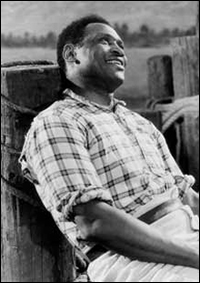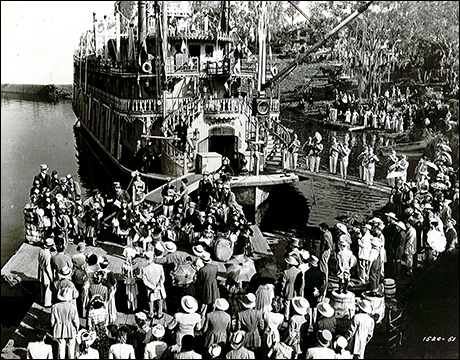
*
The Jerome Kern-Oscar Hammerstein II Show Boat jes' keeps rollin' alon', ever since the illustrious pair adapted Edna Ferber's best-selling novel for the musical stage in 1927. This was a musical with a near-perfect score matched by a pioneering but not exactly workable libretto; as a result it has turned up in many alternate versions over the years. In fact, Kern — at the time of his death in 1945 — was still busy working on new material for Show Boat's undercooked second act.
We'll never see Show Boat as it was in the landmark 1927 production. But we can get a decent idea from one of the film versions. Not the first, a 1929 part-talkie based more closely on the 1926 novel; and certainly not from the third, the colorful, MGM-i-zed 1951 extravaganza. There is however a second filmed Show Boat [Warner Archive], from 1936, which gives us our closest glimpse at the look and the feel of Florenz Ziegfeld's original production.
This film has not been totally impossible to view over the years — it even turns up occasionally on cable — but it has long been obscured. In part due to MGM's efforts to establish their expensive version as the standard; in part due to some sequences that have become racially offensive; and in part due to the persona non grata, blacklisted status of one of the stars.
The 1936 version was thus more or less withdrawn from circulation. A laser disc appeared in 1989, although few consumers ever bothered to buy a laser disc player, and there was an early VHS in 1990. But that's it. Those of us who managed to catch the film somewhere along the way were impressed by a cascade of musical theatre riches and have placed it high on our list of DVD wishes. Now, courtesy of Warner Archive, the 1936 "Show Boat" is here — and provides a dazzlingly important addition to our understanding of the real, authentic Show Boat. This was a movie version of the musical, shot at Universal with a movie director (James Whale, of "Frankenstein"); they did not simply plunk down cameras in the theatre and film the performance. However, the movie was strongly connected to the original stage show and its creators. Ziegfeld was gone; he died in July 1932 during the run of his final show, a gala Broadway return engagement of Show Boat. But Universal, which owned the film rights to the novel and made the 1929 version, asked Kern and Hammerstein to write five new songs (three of which were used); hired Hammerstein to write the screenplay; and filled the leading roles with Show Boat veterans.
| |
 |
|
| Paul Robeson |
The three new songs are of natural interest although they don't much enhance "Show Boat." (The authors presumably agreed; when they produced the 1946 Broadway revival, they did not retain any of the new songs written for London or the 1936 film. They also excised three of the 1927 songs that had already been cut from the film.) "I Have the Room Above Her" is a romantic duet for Ravenal and Magnolia, for a lengthy sequence showing the chaste lovers going off to their separate rooms; this, presumably, to give the two top-billed stars another song. "Ah Still Suits Me" is a duet for Joe and Queenie, presumably to capitalize on the presence of Paul Robeson (as discussed in Part Two of this column).
In London, they added a solo for him ("Me an' My Boss"), but it was cut during the tryout; "Ah Still Suits Me" might indeed have been derived from this presumably lost song. It makes a diverting interlude, with a lazy Joe shelling peas while Queenie cooks, but it doesn't add much to the film or the score.
 |
| The Show Boat at the levee |
| Photo courtesy of Rodgers & Hammerstein, www.rnh.com |
The third song, "Gallivantin' Aroun'," is even more problematic. During the show-within-the-show in the stage version, Frank — the dancing comedian — has a specialty "Villain's Dance." Given that the film Magnolia, Irene Dunne, was a major movie star, they presumably decided to cut Frank's specialty and give one to Irene. Unfortunately, it is a black-face number which offers little plot, entertainment, or musical value. It never again resurfaced — at least with Magnolia doing it in blackface — and is best forgotten. All three are very much of a piece, musically, with the score. "I Have the Room Above Her" seems derived from a patch of "Cap'n Andy's Ballyhoo"; "Ah Still Suits Me" is developed from the Queenie/Joe section of "Can't Help Lovin' Dat Man" ("Ah even loves him when his kisses got gin"); and "Gallivantin' Aroun'" feels like the "white" section of "Cotton Blossom."
Even so, the film score is remarkably close to the original Broadway version. Kern, by this point in his career, hardly made a move without orchestrator Russell Bennett by his side. The original conductor, Victor Baravalle, was also brought out to Hollywood for the film. According to Bennett, he orchestrated the new material but they used most of the New York orchestrations intact, under his supervision. (Bennett later rescored the show for the 1946 and 1966 revivals, more efficiently but without the original richness.) The contributions of Will Vodery, the choral arranger and director, are also retained and wisely so; they play a key part in "Ol' Man River," "Can't Help Lovin' Dat Man" and elsewhere. Additionally — and most unusually — the film uses an enormous amount of the original underscoring; you can sit watching the film with your vocal score and follow along. The overall result is that we get to hear Show Boat pretty much as it sounded in the original production, with a fair number of early cast members. Given that there is no original cast recording of the 1927 show, the 1936 soundtrack is of prime importance.
For a discussion of the cast and other matters, come back next week for a second edition of this column.
(Steven Suskin is author of "Show Tunes", "The Sound of Broadway Music: A Book of Orchestrators and Orchestrations," "Second Act Trouble," the "Broadway Yearbook" series and the "Opening Night on Broadway" books. He also writes the Aisle View blog at The Huffington Post ( www.huffingtonpost.com/steven-suskin/ ). He can be reached at [email protected])










